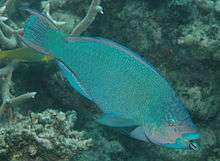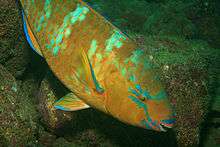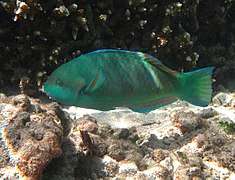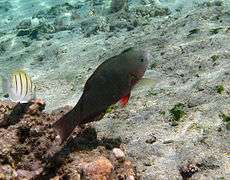Scarus
| Scarus | |
|---|---|
| Scarus ferrugineus, terminal phase | |
| Scientific classification | |
| Kingdom: | Animalia |
| Phylum: | Chordata |
| Class: | Actinopterygii |
| Order: | Perciformes |
| Family: | Scaridae |
| Genus: | Scarus Forsskål, 1775 |
| Species | |
|
about 52, see text | |
Scarus is a genus of parrotfish. With 52 currently recognised extant species,[2] it is by far the largest genus in this group. The vast majority are found at reefs in the Indo-Pacific, but a small number of species are found in the warmer parts of the eastern Pacific and the western Atlantic, with a single species, Scarus hoefleri in the eastern Atlantic. Most are very colourful, and have strikingly different initial (males and females) and terminal (males only) phases. Adults of most species reach maximum lengths of between 30 and 50 cm (12–20 in), but the rainbow parrotfish (Scarus guacamaia) can grow to lengths of 1.2 m (3.9 ft).[2]
Species
There are currently 52 recognised species in this genus:[2]
- Scarus altipinnis - filament-finned parrotfish
- Scarus arabicus - Arabian parrotfish
- Scarus caudofasciatus - red-barred parrotfish
- Scarus chameleon - chameleon parrotfish
- Scarus chinensis
- Scarus coelestinus - midnight parrotfish
- Scarus coeruleus - blue parrotfish
- Scarus collana - Red Sea parrotfish
- Scarus compressus - azure parrotfish
- Scarus dimidiatus - yellow-barred parrotfish
- Scarus dubius - regal parrotfish
- Scarus falcipinnis - sicklefin parrotfish
- Scarus ferrugineus - rusty parrotfish
- Scarus festivus - festive parrotfish
- Scarus flavipectoralis - yellowfin parrotfish
- Scarus forsteni - Forsten's parrotfish
- Scarus frenatus - bridled parrotfish
- Scarus fuscocaudalis - darktail parrotfish
- Scarus fuscopurpureus - purple-brown parrotfish
- Scarus ghobban - blue-barred parrotfish
- Scarus globiceps - globehead parrotfish
- Scarus gracilis
- Scarus guacamaia - rainbow parrotfish
- Scarus hoefleri - Guinean parrotfish
- Scarus hypselopterus - yellowtail parrotfish
- Scarus iseri - striped parrotfish
- Scarus koputea - Marquesan parrotfish
- Scarus longipinnis - highfin parrotfish
- Scarus maculipinna - Spot-fin parrotfish
- Scarus niger - dusky parrotfish
- Scarus obishime - yellowtail parrotfish
- Scarus oviceps - dark-capped parrotfish
- Scarus ovifrons - knobsnout parrotfish
- Scarus perrico - bumphead parrotfish
- Scarus persicus - gulf parrotfish
- Scarus prasiognathos - Singapore parrotfish
- Scarus psittacus - common parrotfish
- Scarus quoyi - Quoy's parrotfish
- Scarus rivulatus - rivulated parrotfish
- Scarus rubroviolaceus - ember parrotfish
- Scarus russelii - eclipse parrotfish
- Scarus scaber - fivesaddle parrotfish
- Scarus schlegeli - yellowband parrotfish
- Scarus spinus - greensnout parrotfish
- Scarus taeniopterus - princess parrotfish
- Scarus tricolor - tricolour parrotfish
- Scarus trispinosus - greenback Parrotfish
- Scarus vetula - queen parrotfish
- Scarus viridifucatus - roundhead parrotfish
- Scarus xanthopleura - red parrotfish
- Scarus zelindae Zelinda's parrotfish
- Scarus zufar - Dhofar parrotfish
In political thought
In Cesare Ripa's Renaissance iconography, the scarus fish symbolised civil "Union," i.e. the joining together of individuals into a collective body. Plutarch had written that scarus fish "swim together in shoals and ingeniously and heroically free each other when caught in a net." The scarus thus "denoted reciprocal assistance in the fight for survival."[3]
Gallery


- Female Scarus falcipinnis


 Male Scarus globiceps
Male Scarus globiceps Female Scarus psittacus
Female Scarus psittacus Male Scarus psittacus
Male Scarus psittacus

Notes
| Wikimedia Commons has media related to Scarus. |
- ↑ Sepkoski, J. (2002). "A compendium of fossil marine animal genera". Bulletins of American Paleontology. 364: 560. Retrieved 25 December 2007.
- 1 2 3 Froese, R. and D. Pauly, Eds. Scarus. FishBase. 2013.
- ↑ Hont, I. Jealousy of Trade: International Competition and the Nation-State in Historical Perspective. Harvard UP: 2005, pp. 21-22.